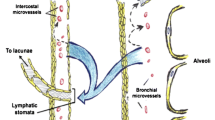Abstract
Background
Pleurodesis for end-of-life care has been used in adults for decades, but little is known about the usefulness of this technique in improving the quality of care for pediatric patients.
Objective
To assess whether intractable pleural effusions in pediatric oncology patients at end of life could be sufficiently relieved by pleurodesis.
Material and methods
Eleven pleurodeses were performed with doxycycline in seven pediatric cancer patients (age 3–21 years) with intractable pleural effusions at the end of life. Five patients had unilateral pleurodeses and two had a unilateral followed by bilateral pleurodeses.
Results
Respiratory rates decreased in all seven patients (P = 0.016) and aeration improved significantly after chest tube placement (P = 0.033). The chest tubes were placed a median of 1 day before pleurodesis. Eight of nine chest tubes (89%) were removed before discharge at a median of 3 days after pleurodesis. Pain secondary to the pleurodesis lasted 1 day or less. Improvement in the respiratory rate remained after pleurodesis and chest tube removal (P = 0.031). Five of seven patients (70%) were able to leave the hospital to return home. The five patients discharged lived 10 to 49 days (median 19 days) after discharge.
Conclusion
Pediatric oncology patients with intractable effusions at end of life can have respiratory benefit from pleurodeses and, as a result, are more likely to return home for terminal care.


Similar content being viewed by others
References
Adler RH, Sayek I (1976) Treatment of malignant pleural effusion: a method using tube thoracostomy and talc. Ann Thorac Surg 22:8–15
Chen YM, Shih JF, Yang KY et al (2000) Usefulness of pig-tail catheter for palliative drainage of malignant pleural effusions in cancer patients. Support Care Cancer 8:423–426
Herrington JD, Gora-Harper ML, Salley RK (1996) Chemical pleurodesis with doxycycline 1 g. Pharmacotherapy 16:280–285
Cytel Software Corporation (2002) Proc-StatXact 5 for SAS users. Statistical software for exact nonparametric inference. User manual. Cytel Software Corporation, Cambridge, MA, pp 73–80
Cytel Software Corporation (2002) Proc-StatXact 5 for SAS users. Statistical software for exact nonparametric inference. User manual. Cytel Software Corporation, Cambridge, MA, pp 112–119
Cytel Software Corporation (2002) Proc-StatXact 5 for SAS users. Statistical software for exact nonparametric inference. User manual. Cytel Software Corporation, Cambridge, MA, pp 135–139
Guo YB, Kalomenidis I, Hawthorne M et al (2005) Pleurodesis is inhibited by anti-vascular endothelial growth factor antibody. Chest 128:1790–1797
Guo YB, Xie CM, Light RW (2006) Effect of anti-vascular endothelial growth factor antibody on pleurodesis induced by transforming growth factor-beta or doxycycline in rabbits. Zhonghua Jie He He Hu Xi Za Zhi 29:39–43
Kaneko T, Konno H, Baba M et al (2003) Urokinase-type plasminogen activator expression correlates with tumor angiogenesis and poor outcome in gastric cancer. Cancer Sci 94:43–49
Wong KS, Liu HP, Yeow KM (2000) Spontaneous pneumothorax in children. Acta Paediatr Taiwan 41:263–265
Tan C, Sedrakyan A, Browne J et al (2006) The evidence on the effectiveness of management for malignant pleural effusion: a systematic review. Eur J Cardiothorac Surg 29:829–838
Pollak JS, Burdge CM, Rosenblatt M et al (2001) Treatment of malignant pleural effusions with tunneled long-term drainage catheters. J Vasc Interv Radiol 12:201–208
Tremblay A, Michaud G (2006) Single-center experience with 250 tunneled pleural catheter insertions for malignant pleural effusion. Chest 129:362–368
Acknowledgements
We thank graduate student Yi Ma for help with this analysis. This work was supported in part by Cancer Center Support (CORE) grant CA 21765 from the National Cancer Institute and by the American Lebanese Syrian Associated Charities (ALSAC).
Author information
Authors and Affiliations
Corresponding author
Rights and permissions
About this article
Cite this article
Hoffer, F.A., Hancock, M.L., Hinds, P.S. et al. Pleurodesis for effusions in pediatric oncology patients at end of life. Pediatr Radiol 37, 269–273 (2007). https://doi.org/10.1007/s00247-006-0392-y
Received:
Revised:
Accepted:
Published:
Issue Date:
DOI: https://doi.org/10.1007/s00247-006-0392-y



